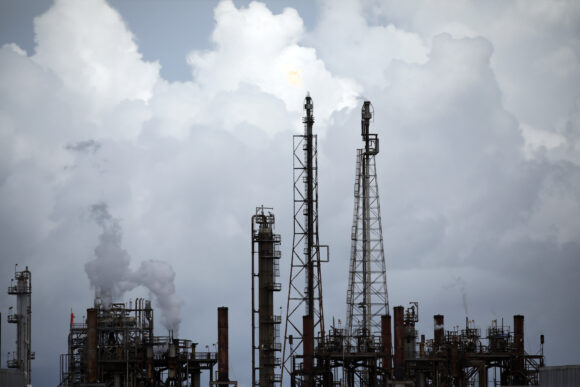Francine strengthened into a hurricane and is expected to make landfall in Louisiana Wednesday after causing some offshore oil platforms to be shuttered, but it will likely miss major natural gas export plants.
On its current track, Francine could graze Morgan City, with impacts from its winds extending as far east as New Orleans, before pushing into Mississippi. Aside from coastal flooding caused by a storm surge that may reach as high as 10 feet (3 meters), there is a moderate chance of flash flooding for New Orleans and other parts of southeastern Louisiana, the US Weather Prediction Center said.
With top winds of 75 miles (120 kilometers) per hour, the storm has become a hurricane, the National Hurricane Center said in an advisory at 7 p.m. Houston time. Francine is expected to bypass liquefied natural gas facilities clustered around the Texas-Louisiana border, including Cheniere Energy Inc.’s Sabine Pass terminal.
Earlier forecasts that Francine would reach Category 2 on the Saffir-Simpson scale have been revised downward, with its top winds now expected to reach 90 mph, making it a Category 1 storm. Still, Francine will likely cause $2.7 billion in damage and losses, said Chuck Watson, a disaster modeler with Enki Research. There is a chance it will weaken as it comes ashore, which would drop losses to about $1 billion. Francine would be the third hurricane to hit the US mainland this year.
Louisiana Governor Jeff Landry declared a state of emergency as Francine approached. A hurricane warning is in effect for a small slice of the Louisiana coast, from Cameron to Grand Isle. Storm surge warnings are in place from Sabine Pass to the Mississippi-Alabama border, as well as Lake Pontchartrain, Lake Maurepas and Vermilion Bay near New Orleans.
Chevron Corp., Exxon Mobil Corp. and Shell Plc are among companies taking measures like evacuating workers from vulnerable installations, suspending drilling activities and shutting in some wells. Federal officials said the total amount of shut-in oil represented nearly a quarter of current crude production in the Gulf of Mexico. Gas supply to US LNG export plants was down 3.2% Tuesday from a day earlier. Eight Gulf Coast refineries also lie in the storm’s track. Residents near Exxon Mobil’s Beaumont, Texas refinery were warned to shelter in place and seal doorways, in case of a gas release from the plant.
Meanwhile, the US Coast Guard declared Port Condition Yankee Tuesday at Beaumont, Port Arthur, and other key Texas ports, a warning that rough weather is expected within 24 hours. Louisiana’s Port Fourchon also began emergency evacuations.
One upside to Francine as it moves ashore is that it will bring much-needed water to the parched Mississippi River, where low water levels have threatened to roil shipments of everything from corn to gasoline. But rains will make field work harder, delaying harvests and reducing grain quality.
The hurricane center is tracking two other disturbances in the central Atlantic Ocean with the potential to become tropical storms. Both are hundreds of miles from populated areas.
Photo: The Royal Dutch Shell Plc Norco refinery in Norco, Louisiana, US. Photographer: Luke Sharrett/Bloomberg
Was this article valuable?
Here are more articles you may enjoy.



 Risks Too Big for Insurers Just Fed a $200 Billion Market Boom in Captives
Risks Too Big for Insurers Just Fed a $200 Billion Market Boom in Captives  How One Florida Engineer Charged Others With Fraudulent Insurance Reports, Testimony
How One Florida Engineer Charged Others With Fraudulent Insurance Reports, Testimony  Update: NYC’s Largest Cab Insurer Ordered to Explore Sale After Losses
Update: NYC’s Largest Cab Insurer Ordered to Explore Sale After Losses  Main Street America Insurance Exits Personal Lines
Main Street America Insurance Exits Personal Lines 

